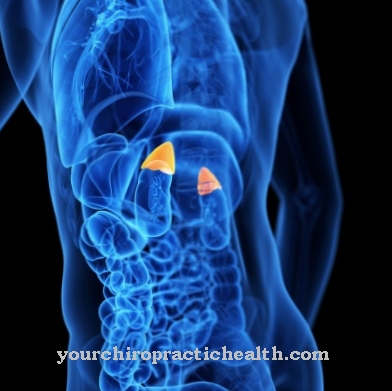The human digestive system is constantly on the move. This is necessary to transport absorbed substances in the body to the organs. With peristalsis This is understood to mean the muscle activity of the hollow organs in the body that serve this digestion. A distinction can be made between forward and backward peristalsis.
What is peristalsis?
Hollow organs are organs whose hollow space is enclosed by a tissue. This includes, for example, the esophagus, stomach and intestines. The movements of these organs, called peristalsis, happen in waves and in bursts.
Function & task

The peristalsis is controlled by nerve cell plexuses that are autonomously controlled in the intestinal wall. The neuronal regulation of peristalsis is the responsibility of the enteric nervous system. Four types of movement are distinguished in intestinal peristalsis.
The contraction of the normally smooth muscles moves in a ring-shaped manner in propulsive peristalsis. It transports the contents of the hollow organ in one direction. After eating, the chyme gets through the stomach into the duodenum and then in small portions further into the small intestine. The further transport into the small intestine section also only takes place in batches.
As the pulp is passed, it is mixed with digestive fluids and enzymes. The transport can take different lengths of time and varies from person to person. However, the amount of fiber and the fluid consumed also play a role in transport. If there is little fluid in the organism, transport in the digestive system can be delayed. The process by which the intestinal wall moves forward and back again is also known as intestinal motility. The autonomic nervous system is responsible for the functioning of the peristalsis.
The local reflexes are particularly influenced by the interplay between the sympathetic and parasympathetic nervous systems, which ensure a fine regulation of organ activity. The parasympathetic nervous system is part of the autonomic nervous system. It slows down the heart rate and promotes digestion. The nerve network on the intestinal wall reacts to these signals and leads to rhythmic tension and relaxation of the muscles. The food pulp is transported further.
The non-propulsive peristalsis is the mixing of the intestinal contents. The contraction waves are ring-shaped and triggered by local reflexes. This step is also known as rhythmic segmentation.
If the transport proceeds in a normal rhythm and in the right direction, it is referred to as orthograde peristalsis. If the normal direction of transport is reversed, for example due to a surgical procedure, or a slowdown in the throughput time, retrograde peristalsis is present.
In retrograde peristalsis, the chyme does not get into the intestines, but is transported back through the esophagus. Vomiting is the side effect that results from this process. This mechanism can also be found in ruminants - deliberately in their case.
The process of retrograde peristalsis is also an important process in the large intestine. The large intestine is driven by the mass movements that take place at periodic intervals. These movements occur up to three times a day. The contents of the intestine are carried to the rectum and the gastro-ecological reflex allows the stool to be eliminated.
Increased peristalsis can be seen when food has just been consumed. The bowel movement is particularly stimulated during periods of rest and slow walks. In many people, the intake of caffeine also causes an increase in peristalsis.
You can find your medication here
➔ Medication for diarrheaIllnesses & ailments
If the body is very focused and very focused on performance, the peristalsis is reduced and the gastrointestinal activity is largely switched off. If inflammation in the abdominal cavity paralyzes the intestinal muscles, a reduction in peristalsis can also be seen.
Noises can be heard in the stomach and intestines during peristalsis. The varying intensity of the noises enables a doctor to assess diseases. The possible diseases are clarified with the help of an examination.
If the peristalsis mixes too large pieces of food or thin liquids, it creates bubbling noises. Flatulence is also noticeable in the form of bowel noises. The air bubbles move through the intestines, creating sounds in this way.
The doctor uses a stethoscope to better localize and interpret bowel sounds. The normal bowel sounds are brisk and lively over all four quadrants of the abdominal corner. An ultrasound examination of the abdomen also provides information about the movement in the gastrointestinal area. Magnetic marker monitoring is a newly developed method that makes it possible to follow and analyze the digestive process with a capsule that is swallowed by the patient.
If the bubbling proves to be very violent, it may indicate diarrhea. If the patient suffers from the food intolerance to lactose intolerance, intestinal noises can also be heard.
If no sound can be heard during an examination of the intestines, in most cases this indicates an intestinal obstruction (ileus). In this case, paralysis of the intestinal wall occurs. If severe abdominal pain and blood in the stool are another symptom, a doctor should be consulted who will make a diagnosis and develop a treatment plan.
The intestinal obstruction can also be mechanical. The intestinal wall tries to break through the occlusion point. This process allows the intestinal noises to be perceived more intensely. A cause of a mechanical ileus can be a foreign body in the intestine or a cancerous ulcer.
A clear diagnosis is not yet possible on the basis of the intestinal noises. Further diagnostic measures will be taken to find out the exact cause. Depending on the disease in the intestine, medicinal or surgical procedures are used as therapy. If it is a tumor or a mechanical ileus, surgery is the only way out.





.jpg)







.jpg)

.jpg)
.jpg)











.jpg)